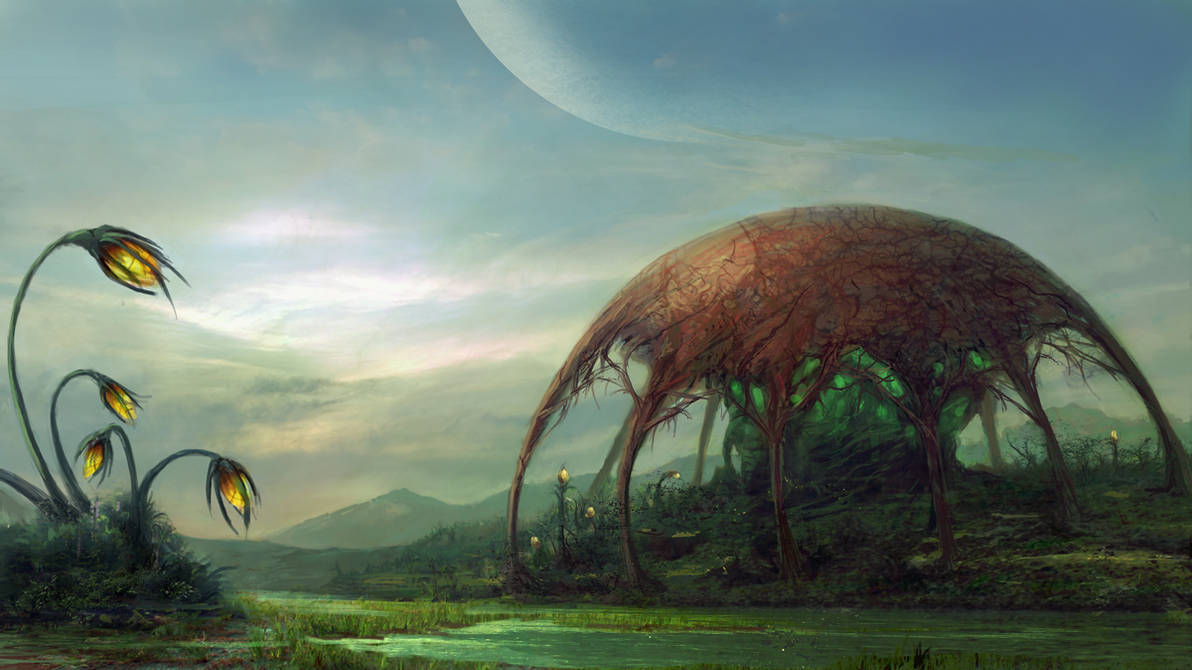
| Main | Neocene |

All pictures are taken from open sources and belong to their authors
A series of articles describing possible life-suitable planets
and the possible inhabitants of alternative “earths” is already quite extensive.
However, a common snippet in almost all cases is the conclusion that conditions
different from those on Earth may nevertheless be suitable for some unassuming
microorganisms. Of course, it’s not about the life “based on other principles”,
that can thrive in liquid gases or feed on liquid stone, because the reasoning
on this topic makes sense only if the ideas about the aforementioned “other
principles” are clear and detailed. And the appearance of such ones, as a rule,
means a sudden realization that these “other principles” do not work.
That is, the conditions for life worse than on the Earth in one way or another
are relatively easy to imagine. So, what about the better ones? How will the
planet look, which is more habitable compared to our one?
...It’s probably worth starting from the star. The mass of the Sun corresponds
to the upper limit of the masses of the luminaries which habitable planets can
revolve around. So, let’s take something hefty, but more modest — 0.8-0.9 solar
mass. It will provide a higher level of stability of the conditions. In 4 billion
years, the luminosity of the star will increase not by 40, but by 25-30 per
cent. The latter means that the planet can be brought closer to the light source.
At the time of the formation of the Solar System, the Earth was at the outer
boundary of the habitable zone. And already in the Archean it began to suffer
from the cold, even freezing completely at least once. Curiously, the hot climate
of the Paleozoic and Mesozoic was a consequence of these difficulties. Due to
the relatively small area of tropical shallow waters where synthesis took place
in earlier epochs, the problem of carbon dioxide mineralization was solved very
late. By the time the Sun had already flared up properly, the atmosphere still
created a strong greenhouse effect.
On an “ideal planet” with an initially high but stable illumination level, life
will arise somewhat later, since initially, until the heat remaining from the
formation stage dissipates, water can exist only in the form of steam. But this
lag will be quickly made up due to more favorable conditions for synthesis and
the absence of glaciation.
The positive effects of stability can be further enhanced by some increase in
the mass of the planet itself. As a result, we’ll get a world, where the ozone
layer and an oxidizing atmosphere are formed early, and the land is covered
to the poles with dark-leaved vegetation even during the period corresponding
to the Cambrian of the Earth. It takes place because the spectrum of the star,
compared with the solar one, is shifted to the red zone, and the modification
of chlorophyll corresponding to long waves is red.
In a certain sense, a planet which orbit is close to circular, and the axis
of rotation is strictly vertical, can be considered as an ideal one. In such
a world, there will be no change of seasons. But whether it turns out to be
an advantage or a disadvantage depends on the average temperature. If the climate
on the planet in general is hot, as on Earth in the Cretaceous period, or at
least very warm, as in the Paleogene, the effects of the absence of seasons
will not be too bright and, rather, positive. In temperate latitudes, the climate,
already warm, will become mild “oceanic” without heat and cold. Then, closer
to the equator, the change of seasons in any case is felt on the scale of natural
disasters. The amount of disasters will be fewer, but the rest will remain the
same.
On a planet with an initially temperate climate, like the Earth’s modern one,
the consequences of the lack of seasonality will be favorable in the tropics
and partly in the subtropics, where the temperature will become more comfortable
and rather unpleasant in temperate latitudes. For example, in the Moscow region,
the average annual air temperature will be only four degrees Celsius. So, it
will turn out to be an eternal spring, but spring will be too early. The pointer
of the thermometer will start to beat up and down randomly between +20 and -10
degrees, depending on whether the wind blows from the north or from the south.
Night frosts will become the rule. Several times in an astronomical year, snow
will fall (and melt in a few days). For plants, this mode is extremely inconvenient.
It will be especially difficult for flowering plants. Mixed forests will be
replaced by taiga with dark needles. Of course, beasts and birds will manage
to adapt to frosts – but not to the foodless. Amphibians, reptiles and insects
(except for “warm-blooded” bumblebees) will hardly be able to tolerate the conditions
of the off-season, in which it is impossible to prepare for frosts in advance.
Farther north the things will get really bad. The Arctic Ocean, Siberia to the
Amur river and most of Canada will disappear under the glacier. Wherever the
average temperature is below zero, the ice will not have time to melt during
the snowbreaks. Only mosses and lichens rooted on the rocks protruding from
the snow will survive here.
The tilt of the rotation axis of the planet not only diversifies the life of
its inhabitants with spring blooms and autumn colors, but also expands the habitable
area. Even in the Arctic, in the territories “unfreezing” for only for three
or four months a year, during the short summer, animals gain fat, and plants
create biomass that can be extracted from under the snow at the polar night.
Translated by Pavel Volkov, 2021
The original Russian article is here
| Main | Neocene |